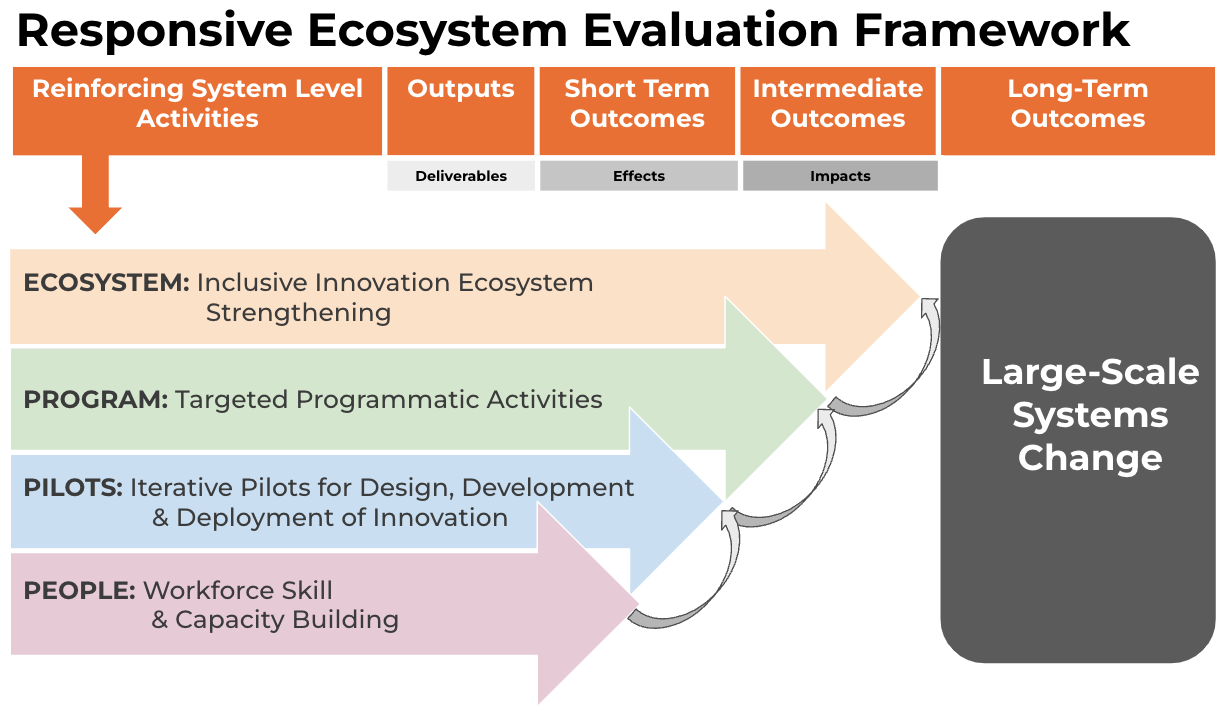https://hdl.handle.net/1808/35612
Teri A. Garstka1, Meaghan Kennedy2, and Michaela Bonnett2
1Social Innovation Labs, The University of Kansas, 2Orange Sparkle Ball
Series: Ecosystems Designed for Change
Original Publication Date: November 7th, 2024
Publisher: University of Kansas Libraries
Abstract
Ecosystems Designed for Change: An Evaluation Framework for Innovators & Leaders
This white paper in the Responsive Ecosystems for Change Series presents an evaluation framework to guide practitioners and ecosystem leaders toward a comprehensive approach for measuring change and impact. It discusses methodologies and analyses specifically designed for complex systems change at many levels. This paper walks readers through the framework, concepts, and examples to improve their understanding of how to evaluate a social ecosystem and measure its collective impact at scale.
Citation List
1. Touliou, Katerina, and Evangelos Bekiaris. "Building an inclusive ecosystem for developers and users: the role of value propositions." In Advances in Ergonomics Modeling, Usability & Special Populations: Proceedings of the AHFE 2016 International Conference on Ergonomics Modeling, Usability & Special Populations, July 27-31, 2016, Walt Disney World®, Florida, USA, pp. 339-346. Springer International Publishing, 2017.
2. Duarte Alonso, Abel, Seng Kiat Kok, Seamus O'Brien, and Michelle O'Shea. "The significance of grassroots and inclusive innovation in harnessing social entrepreneurship and urban regeneration." European Business Review 32, no. 4 (2020): 667-686.
3. Mitchell, Jess, and Jutta Treviranus. Chapter 4 - Inclusive Design in Ecosystems. In: Vimarlund V, editor. E-Health Two-Sided Markets [Internet]. Academic Press; 2017 [cited 2024 Jul 5]. p. 43–61. Available from: https://www.sciencedirect.com/scie nce/article/pii/B9780128052501000 06X.
4. Aguinis, Herman, Ryan K. Gottfredson, and Steven Andrew Culpepper. “Best-Practice Recommendations for Estimating Cross-Level Interaction Effects Using Multilevel Modeling.” Journal of Management 39, no. 6 (September 1, 2013): 1490–1528. https://doi.org/10.1177/014920631347 8188.
5. Sommet, Nicolas, and Davide Morselli. "Keep calm and learn multilevel logistic modeling: A simplified three-step procedure using Stata, R, Mplus, and SPSS." International Review of Social Psychology 30 (2017): 203-218.
6. Guevara, Tom, Alexander Kersten, and Srishti Khemka. “Inclusive Innovation for U.S. Economic Growth and Resiliency,” May 30, 2023. https://www.csis.org/analysis/inclus ive-innovation-us-economic-growt h-and-resiliency.
7. Orange Sparkle Ball. “The Innovation Stack”; 2023. https://www.orangesparkleball.com /how-we-do-it.





